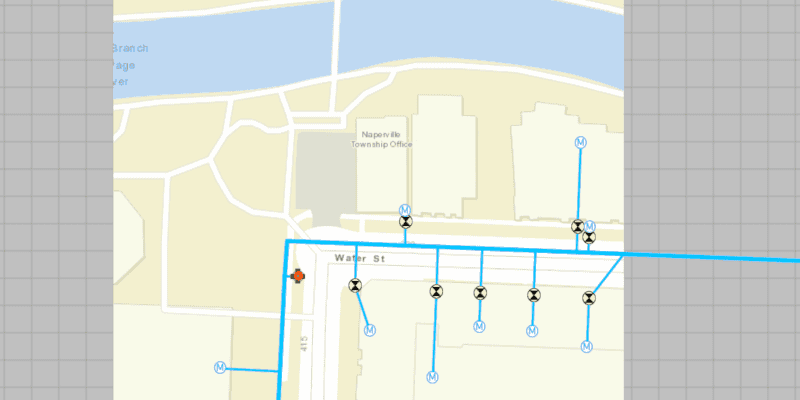Take a web map offline.

Use case
Taking a web map offline allows users continued productivity when their network connectivity is poor or nonexistent. For example, by taking a map offline, a field worker inspecting utility lines in remote areas could still access a feature's location and attribute information.
How to use the sample
Once the map loads, zoom to the extent you want to take offline. The red border shows the extent that will be downloaded. Click the "Take Map Offline" button to start the offline map job. The progress bar will show the job's progress. When complete, the offline map will replace the online map in the map view.
How it works
- Create an
ArcGISMapwith aPortalitem pointing to the web map. - Create
GenerateOfflineMapParametersspecifying the download area geometry, minimum scale, and maximum scale. - Create an
OfflineMapTaskwith the map. - Create the
OfflineMapJobwithofflineMapTask.generateOfflineMap(params, downloadDirectoryPath)and start it withofflineMapJob.start(). - When the job is done, get the offline map with
offlineMapJob.getResult().getOfflineMap().
Relevant API
- GenerateOfflineMapJob
- GenerateOfflineMapParameters
- GenerateOfflineMapResult
- OfflineMapTask
- Portal
About the data
The map used in this sample shows the stormwater network within Naperville, IL, USA, with cartography designed for web and mobile devices with offline support.
Additional information
The creation of the offline map can be fine-tuned using parameter overrides for feature layers, or by using local basemaps to achieve more customised results.
Tags
download, offline, save, web map
Sample Code
/*
* Copyright 2018 Esri.
*
* Licensed under the Apache License, Version 2.0 (the "License"); you may not
* use this file except in compliance with the License. You may obtain a copy of
* the License at
*
* http://www.apache.org/licenses/LICENSE-2.0
*
* Unless required by applicable law or agreed to in writing, software
* distributed under the License is distributed on an "AS IS" BASIS, WITHOUT
* WARRANTIES OR CONDITIONS OF ANY KIND, either express or implied. See the
* License for the specific language governing permissions and limitations under
* the License.
*/
package com.esri.samples.generate_offline_map;
import java.io.IOException;
import java.nio.file.Files;
import java.nio.file.Path;
import javafx.application.Application;
import javafx.application.Platform;
import javafx.geometry.Point2D;
import javafx.geometry.Pos;
import javafx.scene.Scene;
import javafx.scene.control.Alert;
import javafx.scene.control.Button;
import javafx.scene.control.ProgressBar;
import javafx.scene.layout.StackPane;
import javafx.stage.Stage;
import com.esri.arcgisruntime.ArcGISRuntimeEnvironment;
import com.esri.arcgisruntime.concurrent.Job;
import com.esri.arcgisruntime.geometry.Envelope;
import com.esri.arcgisruntime.geometry.Point;
import com.esri.arcgisruntime.loadable.LoadStatus;
import com.esri.arcgisruntime.mapping.ArcGISMap;
import com.esri.arcgisruntime.mapping.view.Graphic;
import com.esri.arcgisruntime.mapping.view.GraphicsOverlay;
import com.esri.arcgisruntime.mapping.view.MapView;
import com.esri.arcgisruntime.portal.Portal;
import com.esri.arcgisruntime.portal.PortalItem;
import com.esri.arcgisruntime.symbology.SimpleLineSymbol;
import com.esri.arcgisruntime.tasks.offlinemap.GenerateOfflineMapJob;
import com.esri.arcgisruntime.tasks.offlinemap.GenerateOfflineMapParameters;
import com.esri.arcgisruntime.tasks.offlinemap.GenerateOfflineMapResult;
import com.esri.arcgisruntime.tasks.offlinemap.OfflineMapTask;
public class GenerateOfflineMapSample extends Application {
private ArcGISMap map; // keep loadable in scope to avoid garbage collection
private MapView mapView;
@Override
public void start(Stage stage) {
try {
// create stack pane and application scene
StackPane stackPane = new StackPane();
Scene scene = new Scene(stackPane);
// set title, size, and add scene to stage
stage.setTitle("Generate Offline Map Sample");
stage.setWidth(800);
stage.setHeight(700);
stage.setScene(scene);
stage.show();
// authentication with an API key or named user is required to access basemaps and other location services
String yourAPIKey = System.getProperty("apiKey");
ArcGISRuntimeEnvironment.setApiKey(yourAPIKey);
// create a button to take the map offline
Button offlineMapButton = new Button("Take Map Offline");
offlineMapButton.setDisable(true);
// create a portal item with the itemId of the web map
var portal = new Portal("https://www.arcgis.com");
var portalItem = new PortalItem(portal, "acc027394bc84c2fb04d1ed317aac674");
// create a map with the portal item
map = new ArcGISMap(portalItem);
map.addDoneLoadingListener(() -> {
// enable the button when the map is loaded
if (map.getLoadStatus() == LoadStatus.LOADED) {
offlineMapButton.setDisable(false);
}
});
// set the map to the map view
mapView = new MapView();
mapView.setMap(map);
// create a graphics overlay for the map view
var graphicsOverlay = new GraphicsOverlay();
mapView.getGraphicsOverlays().add(graphicsOverlay);
// create a graphic to show a box around the extent we want to download
Graphic downloadArea = new Graphic();
graphicsOverlay.getGraphics().add(downloadArea);
SimpleLineSymbol simpleLineSymbol = new SimpleLineSymbol(SimpleLineSymbol.Style.SOLID, 0xFFFF0000, 2);
downloadArea.setSymbol(simpleLineSymbol);
// update the box whenever the viewpoint changes
mapView.addViewpointChangedListener(viewpointChangedEvent -> {
if (map.getLoadStatus() == LoadStatus.LOADED) {
// upper left corner of the area to take offline
Point2D minScreenPoint = new Point2D(50, 50);
// lower right corner of the downloaded area
Point2D maxScreenPoint = new Point2D(mapView.getWidth() - 50, mapView.getHeight() - 50);
// convert screen points to map points
Point minPoint = mapView.screenToLocation(minScreenPoint);
Point maxPoint = mapView.screenToLocation(maxScreenPoint);
// use the points to define and return an envelope
if (minPoint != null && maxPoint != null) {
Envelope envelope = new Envelope(minPoint, maxPoint);
downloadArea.setGeometry(envelope);
}
}
});
// create progress bar to show download progress
var progressBar = new ProgressBar(0.0);
progressBar.setVisible(false);
// when the button is clicked, start the offline map task job
offlineMapButton.setOnAction(e -> {
try {
// show the progress bar
progressBar.setVisible(true);
// specify the extent, min scale, and max scale as parameters
double minScale = mapView.getMapScale();
double maxScale = map.getMaxScale();
// minScale must always be larger than maxScale
if (minScale <= maxScale) {
minScale = maxScale + 1;
}
GenerateOfflineMapParameters params = new GenerateOfflineMapParameters(downloadArea.getGeometry(), minScale, maxScale);
// create an offline map task with the map
OfflineMapTask task = new OfflineMapTask(map);
// create an offline map job with the download directory path and parameters and start the job
Path tempDirectory = Files.createTempDirectory("offline_map");
GenerateOfflineMapJob job = task.generateOfflineMap(params, tempDirectory.toAbsolutePath().toString());
job.start();
job.addJobDoneListener(() -> {
if (job.getStatus() == Job.Status.SUCCEEDED) {
// replace the current map with the result offline map when the job finishes
GenerateOfflineMapResult result = job.getResult();
mapView.setMap(result.getOfflineMap());
graphicsOverlay.getGraphics().clear();
offlineMapButton.setDisable(true);
} else {
new Alert(Alert.AlertType.ERROR, job.getError().getAdditionalMessage()).show();
}
Platform.runLater(() -> progressBar.setVisible(false));
});
// show the job's progress with the progress bar
job.addProgressChangedListener(() -> progressBar.setProgress(job.getProgress() / 100.0));
} catch (IOException ex) {
new Alert(Alert.AlertType.ERROR, "Failed to create temporary directory").show();
}
});
// add the map view, button, and progress bar to stack pane
stackPane.getChildren().addAll(mapView, offlineMapButton, progressBar);
StackPane.setAlignment(offlineMapButton, Pos.TOP_LEFT);
StackPane.setAlignment(progressBar, Pos.TOP_RIGHT);
} catch (Exception e) {
// on any error, display the stack trace.
e.printStackTrace();
}
}
/**
* Stops and releases all resources used in the application.
*/
@Override
public void stop() {
if (mapView != null) {
mapView.dispose();
}
}
/**
* Opens and runs application.
*
* @param args arguments passed to this application
*/
public static void main(String[] args) {
Application.launch(args);
}
}